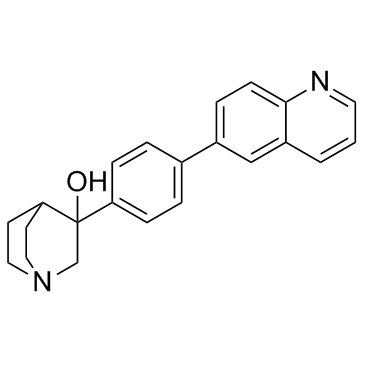RPR107393 free base
Modify Date: 2025-08-25 20:23:53

RPR107393 free base structure
|
Common Name | RPR107393 free base | ||
|---|---|---|---|---|
| CAS Number | 197576-78-6 | Molecular Weight | 330.42 | |
| Density | N/A | Boiling Point | N/A | |
| Molecular Formula | C22H22N2O | Melting Point | N/A | |
| MSDS | N/A | Flash Point | N/A | |
Use of RPR107393 free baseRPR107393 free base is a selective squalene synthase inhibitor, which inhibits rat liver microsomal squalene synthase with an IC50 of 0.8±0.2 nM. |
| Name | RPR107393 free base |
|---|
| Description | RPR107393 free base is a selective squalene synthase inhibitor, which inhibits rat liver microsomal squalene synthase with an IC50 of 0.8±0.2 nM. |
|---|---|
| Related Catalog | |
| Target |
IC50: 0.8±0.2 nM (rat liver microsomal squalene synthase)[1] |
| In Vitro | RPR107393 is a selective squalene synthase inhibitor with subnanomolar potency. RPR107393 inhibits rat liver microsomal squalene synthase with an IC50 value of 0.8±0.2 nM (n=4)[1]. In the time-course study, cells are treated with ER-27856 (1 μM), RPR-107393 (10 μM), Atorvastatin (1 μM), or NB-598 (1 μM) for 2-24 h, and lipid biosynthesis during the last 2 h of the incubation is determined. RPR-107393 (10 μM) inhibits Cholesterol biosynthesis and reduces triglyceride biosynthesis. Similarly, 1 μM RPR-107393 inhibits Cholesterol and triglyceride biosynthesis by 82.4% and 70.0%, respectively[2]. |
| In Vivo | One hour after RPR107393 (10 mg/kg p.o.), Cholesterol biosynthesis is reduced by 92% with an approximate ED50 value of 5 mg/kg. Six hours after RPR107393 (10 mg/kg p.o.) administration, Cholesterol biosynthesis is reduced by 74% (the time for 50% inhibition is ~7 hr). An 82% inhibition of hepatic Cholesterol biosynthesis is observed 10 hr after RPR107393 (25 mg/kg p.o.), but the effect is no longer apparent at 21 hr. Inhibition of Cholesterol biosynthesis by Zaragozic acid or RPR107393 is associated with an accumulation of radiolabeled diacid products in the liver. RPR107393 is a potent Cholesterol-lowering agent in rats. RPR107393 (30 mg/kg p.o. b.i.d.) lowers serum Cholesterol by 35% after 2 days and by nearly 50% after 3 days of treatment[1]. |
| Animal Admin | Rats[1] Sprague-Dawley rats weighing 60 to 70 g are given rodent diet and kept under reverse-lighting conditions (lights on, 3:00 p.m. to 3:00 a.m.). Cholestyramine is included in the diet for 2 days before the study to stimulate liver Cholesterol biosynthetic capacity. Drugs are suspended in 0.5% methyl cellulose or dissolved in saline (Zaragozic acid). RPR107393 (10 mg/kg) is given p.o. by gavage, and Zaragozic acid is given s.c.. After a specified time period, the animals receive [14C]Mevalonolactone (15 μCi/kg; 40 Ci/mol) by s.c. injection. Fifteen minutes later, the animals are killed with CO2. The livers are removed, and 0.5 g of the liver is saponified in 2 mL of 15% KOH/ethanol overnight at 80°C. Samples are extracted with petroleum ether in alkaline conditions, and [14C]Cholesterol is quantified by HPLC. |
| References |
| Molecular Formula | C22H22N2O |
|---|---|
| Molecular Weight | 330.42 |
| InChIKey | JICDBMXIQNEXKV-UHFFFAOYSA-N |
| SMILES | OC1(c2ccc(-c3ccc4ncccc4c3)cc2)CN2CCC1CC2 |
| Storage condition | 2-8℃ |